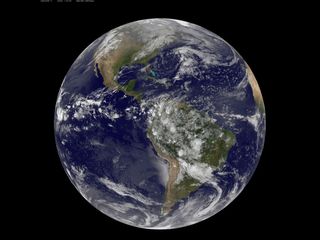Earth Day from Space: Satellite Snaps Far-Out Photo (Image)

A U.S. satellite has captured the ultimate Earth Day view from space, showing the entire planet in a stunning group shot of humanity.
The photo, taken today (April 22) to mark Earth Day, was captured by the GOES-East satellite at 7:45 a.m. EDT (1145 GMT) and released by NASA. It shows North and South America as viewed from 22,300 miles (35,888 kilometers) above the planet.
A close look at the Earth Day image from space reveals a cold front (identified by its clouds) stretching from Montreal, Canada to the southern Texas, passing through the Tennessee Valley on its way, according to a NASA image description. Another weather system along the Pacific Northwest is also visible and likely to bring rain to the states of Oregon, Washington, Idaho and other Midwestern locales. [Amazing Photos of Earth from Space]
Near the Earth's equator, a line of thunderstorms associated with the so-called Intertropical Convergence Zone (ITCZ), a weather zone that encircles the equator, can be seen as more storm clouds blanket parts of Columbia, Venezuela, Ecuador, Peru, Bolivia, Paraguay and Brazil, according to NASA's description.
The GOES satellites make up a constellation of Earth-watching spacecraft that provides constant monitoring of the planet for data analysis. The satellites fly in so-called geostationary orbits that allow them to hover over a specific point of Earth for continuous weather monitoring.
The GOES program is overseen by the National Oceanic and Atmospheric Administration and NASA's Goddard Space Flight Center in Greenbelt, Md.
Email Tariq Malik at tmalik@space.com or follow him @tariqjmalik and Google+. Follow us @Spacedotcom, Facebook and Google+. Original article on Space.com.
Get the Space.com Newsletter
Breaking space news, the latest updates on rocket launches, skywatching events and more!
Join our Space Forums to keep talking space on the latest missions, night sky and more! And if you have a news tip, correction or comment, let us know at: community@space.com.

Tariq is the Editor-in-Chief of Space.com and joined the team in 2001, first as an intern and staff writer, and later as an editor. He covers human spaceflight, exploration and space science, as well as skywatching and entertainment. He became Space.com's Managing Editor in 2009 and Editor-in-Chief in 2019. Before joining Space.com, Tariq was a staff reporter for The Los Angeles Times covering education and city beats in La Habra, Fullerton and Huntington Beach. In October 2022, Tariq received the Harry Kolcum Award for excellence in space reporting from the National Space Club Florida Committee. He is also an Eagle Scout (yes, he has the Space Exploration merit badge) and went to Space Camp four times as a kid and a fifth time as an adult. He has journalism degrees from the University of Southern California and New York University. You can find Tariq at Space.com and as the co-host to the This Week In Space podcast with space historian Rod Pyle on the TWiT network. To see his latest project, you can follow Tariq on Twitter @tariqjmalik.
